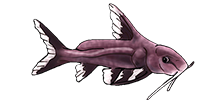"normal" Corydoras fry behavior
"normal" Corydoras fry behavior
Can someone please describe what is considered normal corydoras fry behavior the first few days after hatching?
I am used to egglayer fish which stick to glass and do not swim much while using up yolk sak.
My cory fry hatched sooner than "normal" and now I am wondering how soon I should be feeding them.
How much do they swim vs rest on bottom when free swimming?
Pete
I am used to egglayer fish which stick to glass and do not swim much while using up yolk sak.
My cory fry hatched sooner than "normal" and now I am wondering how soon I should be feeding them.
How much do they swim vs rest on bottom when free swimming?
Pete
- Coryman
- Expert
- Posts: 2119
- Joined: 30 Dec 2002, 19:06
- My articles: 12
- My catfish: 5
- My cats species list: 83 (i:5, k:0)
- My BLogs: 1 (i:0, p:1)
- Spotted: 194
- Location 1: Kidderminster UK
- Location 2: Kidderminster, UK
- Interests: Cory's, Loricariids, photography and more Cory's
- Contact:
Coryman,
Yes, I have read and re-read that thread several times and I am trying to follow the directions very closely (1 gal container in tank, twice a day 50% water changes with tank water, etc.) however;
My Corydoras stenocephalus hatched in only ~1.5-2 days.
“When the yoke sac has been used up the fry are then classed as free swimming and will be actively looking for food”
For three days my fry sat mostly on the bottom but swam around every once in a while especially if disturbed. Normal?
Some seemed to swim in small circles. Normal?
Today, five days after hatching they are actively swimming. Yolk sac absorbed “free swimming I guess?
Today I am also starting to find dead fry. I am feeding with microworms but I am not sure they are eating them. Are any cory fry too small to eat microworms?
I lost my whole last batch in a similar fashion and I am trying to figure what is going on. Not sure if behavior might give a clue.
Pete
Yes, I have read and re-read that thread several times and I am trying to follow the directions very closely (1 gal container in tank, twice a day 50% water changes with tank water, etc.) however;
My Corydoras stenocephalus hatched in only ~1.5-2 days.
“When the yoke sac has been used up the fry are then classed as free swimming and will be actively looking for food”
For three days my fry sat mostly on the bottom but swam around every once in a while especially if disturbed. Normal?
Some seemed to swim in small circles. Normal?
Today, five days after hatching they are actively swimming. Yolk sac absorbed “free swimming I guess?
Today I am also starting to find dead fry. I am feeding with microworms but I am not sure they are eating them. Are any cory fry too small to eat microworms?
I lost my whole last batch in a similar fashion and I am trying to figure what is going on. Not sure if behavior might give a clue.
Pete
- Coryman
- Expert
- Posts: 2119
- Joined: 30 Dec 2002, 19:06
- My articles: 12
- My catfish: 5
- My cats species list: 83 (i:5, k:0)
- My BLogs: 1 (i:0, p:1)
- Spotted: 194
- Location 1: Kidderminster UK
- Location 2: Kidderminster, UK
- Interests: Cory's, Loricariids, photography and more Cory's
- Contact:
My Corydoras stenocephalus hatched in only ~1.5-2 days. This is unusual, I have never heard of Cory eggs hatching so quickly.
“When the yoke sac has been used up the fry are then classed as free swimming and will be actively looking for food” For three days my fry sat mostly on the bottom but swam around every once in a while especially if disturbed. Normal? This is true, this usually takes 2 to 3 days.
Some seemed to swim in small circles. Normal? While there is yoke to be absorbed the fry cannot swim properly.
Today, five days after hatching they are actively swimming. Yolk sac absorbed “free swimming I guess? Yes! free swimming.
Today I am also starting to find dead fry. I am feeding with microworms but I am not sure they are eating them. Are any cory fry too small to eat microworms? Micro worm is my usual first choice, but if the fry are very small (some species are) they may need to be offered a liquid type food, for this I take a a fry flake food and make it into a sloppy paste and offer it to the fry this way.
Ian
“When the yoke sac has been used up the fry are then classed as free swimming and will be actively looking for food” For three days my fry sat mostly on the bottom but swam around every once in a while especially if disturbed. Normal? This is true, this usually takes 2 to 3 days.
Some seemed to swim in small circles. Normal? While there is yoke to be absorbed the fry cannot swim properly.
Today, five days after hatching they are actively swimming. Yolk sac absorbed “free swimming I guess? Yes! free swimming.
Today I am also starting to find dead fry. I am feeding with microworms but I am not sure they are eating them. Are any cory fry too small to eat microworms? Micro worm is my usual first choice, but if the fry are very small (some species are) they may need to be offered a liquid type food, for this I take a a fry flake food and make it into a sloppy paste and offer it to the fry this way.
Ian
-
CoryWally
- Posts: 282
- Joined: 22 Nov 2005, 16:20
- My catfish: 4
- My cats species list: 22 (i:4, k:0)
- My BLogs: 4 (i:0, p:75)
- Spotted: 3
- Location 1: UK
- Location 2: Boston Spa, West Yorks, U.K.
fry feeding
I always put some java moss, or similar plant material, from an established tank in with the fry after they become free swimming. If they can't manage microworms or processed food they can graze on the meiofauna associated with the plant for a short while. I also put a bit of oak leaf from a tank in with the babies.
Dying fry is nearly always lack of the correct food or deteriorating water quality (e.g. uneaten food, dead fry etc), although it can be due to environmental factors such as fluctuating temperature.
Another tip for fry who are stubborn feeders is to add some fry from a more active species to encourage the less active ones.
Good luck,
Mark.
Dying fry is nearly always lack of the correct food or deteriorating water quality (e.g. uneaten food, dead fry etc), although it can be due to environmental factors such as fluctuating temperature.
Another tip for fry who are stubborn feeders is to add some fry from a more active species to encourage the less active ones.
Good luck,
Mark.
Thanks CoryWally & Coryman,
I forgot to mention that the fry were swimming up sides of container yesterday and this morning. I hope this is normal food searching behavior.
I did put java moss in container (for food and water quality) and I also put a small drop of liquid fry food in last night thinking food size was/is the issue.
This morning there were just a few more dead fry and the rest seem active. I am crossing my fingers am getting getting them past the critical point.
The parents laid more eggs yesterday so I can try different foods/techniques with next batch.
Pete
I forgot to mention that the fry were swimming up sides of container yesterday and this morning. I hope this is normal food searching behavior.
I did put java moss in container (for food and water quality) and I also put a small drop of liquid fry food in last night thinking food size was/is the issue.
This morning there were just a few more dead fry and the rest seem active. I am crossing my fingers am getting getting them past the critical point.
The parents laid more eggs yesterday so I can try different foods/techniques with next batch.
Pete






